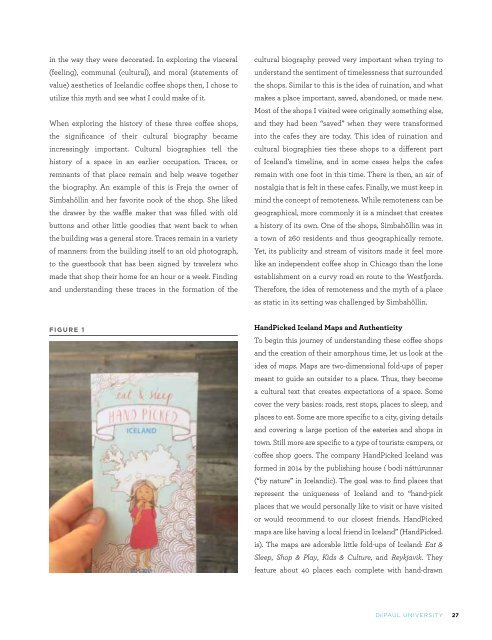UNDERGRADUATE
Ycb5305N2JX
Ycb5305N2JX
Create successful ePaper yourself
Turn your PDF publications into a flip-book with our unique Google optimized e-Paper software.
maps with little people and drawings representing different<br />
places featured on the maps. For example, the cover of the<br />
Eat & Sleep Iceland map features a drawing of a cute girl<br />
eating a fermented shark head (see figure 1). That drawing<br />
by itself portrays a common myth of Iceland as a place<br />
of odd traditional food, while simultaneously making it<br />
accessible to a generation of hip tourists coming for the<br />
more urban Reykjavik experience. Given the company<br />
goal of creating a map that is like having a local friend, two<br />
important questions come up. First, if maps have symbolic<br />
grammar of a place that translates into the translation and<br />
understanding of Iceland by the non-Icelander, what do<br />
these maps say about Iceland? What does the aesthetic<br />
appeal attempt to claim about a real 3D local Icelanderfriend?<br />
The second question centers around what the maps<br />
do not show or tell about Iceland. For example, the Tar<br />
House Fish Restaurant in Isafjordur is not listed on any<br />
of the maps, yet having been, I would say it is certainly a<br />
hub of community in the town and is mostly frequented<br />
by locals, even in the summer. It was a place that our real<br />
3D local Icelander-friends suggested we eat. Why then is<br />
it not on the maps? Perhaps it does not fit the Iceland that<br />
the mapmakers are trying to portray. This could be the case<br />
for a variety of reasons. Although it is a cute place with<br />
large wooden tables in a barn and twinkle lights hanging<br />
throughout, if there is a specific sentiment of Iceland that<br />
the mapmakers desire Iceland to be known for, perhaps it<br />
does not fit. True, all the furniture is uniform there are no<br />
mismatched antique chairs, there are no collectables of any<br />
sort on the walls or tables like in the coffee shops featured<br />
in the maps. In addition, there are no direct ties to artists<br />
of any type. It does however, have traces of the past in its<br />
cultural biography. Isafjordur was long a center for trade<br />
and in 1757 The Shop was built to accommodate trade. In<br />
1782, Tar House was built as the warehouse for the shop<br />
(Creek, fieldnotes). However, there seemed to be a lack of<br />
nick-knacks in the restaurant to document this past, and<br />
perhaps the fact that its history is not mentioned boldly,<br />
unlike some of the coffee shops, make its aesthetic not quite<br />
as “HandPicked” as it needed to be to make the map.<br />
The exclusion of a local-favorite and old restaurant<br />
from the HandPicked Iceland maps is important for a<br />
couple of reasons. One, when looking at specialty maps,<br />
it is equally as important to consider what is not on the<br />
map and why as it is to consider what is on the maps.<br />
The maps themselves invoke a visceral response about<br />
“adorable Iceland” as well as carry a moral weight. The<br />
maps indicate that the important places to eat and visit<br />
are the ones that fit into this idea of tying the past to the<br />
present seamlessly. The maps were created with a specific<br />
type of new traveler in mind. They are ideal for the café<br />
lover, the city lover who came to Iceland to experience the<br />
awe, but who still wants their coffee and a place to read<br />
and write. They appeal to the artist-traveler. Second, this<br />
particular breed of coffee shop or restaurant picked for<br />
these maps reminded me immediately of movie director<br />
Wes Anderson’s aesthetics and the idea of timelessness<br />
felt in his films. I decided to go ahead and explore the<br />
regime behind the Wes Anderson look to see if it was<br />
possible to uncover similarities within the coffee shop<br />
culture of Iceland. If similarities arose, I would be able to<br />
make the claim that Iceland participates intentionally in<br />
its own myth-making and amorphous time.<br />
Wes Anderson films: Representation of Amorphous<br />
Time + Three Places<br />
Tony Bravo writes, “No matter what part of the movie you<br />
happen to come in on, you can always tell when you’ve<br />
FIGURE 2<br />
28 CREATING KNOWLEDGE


